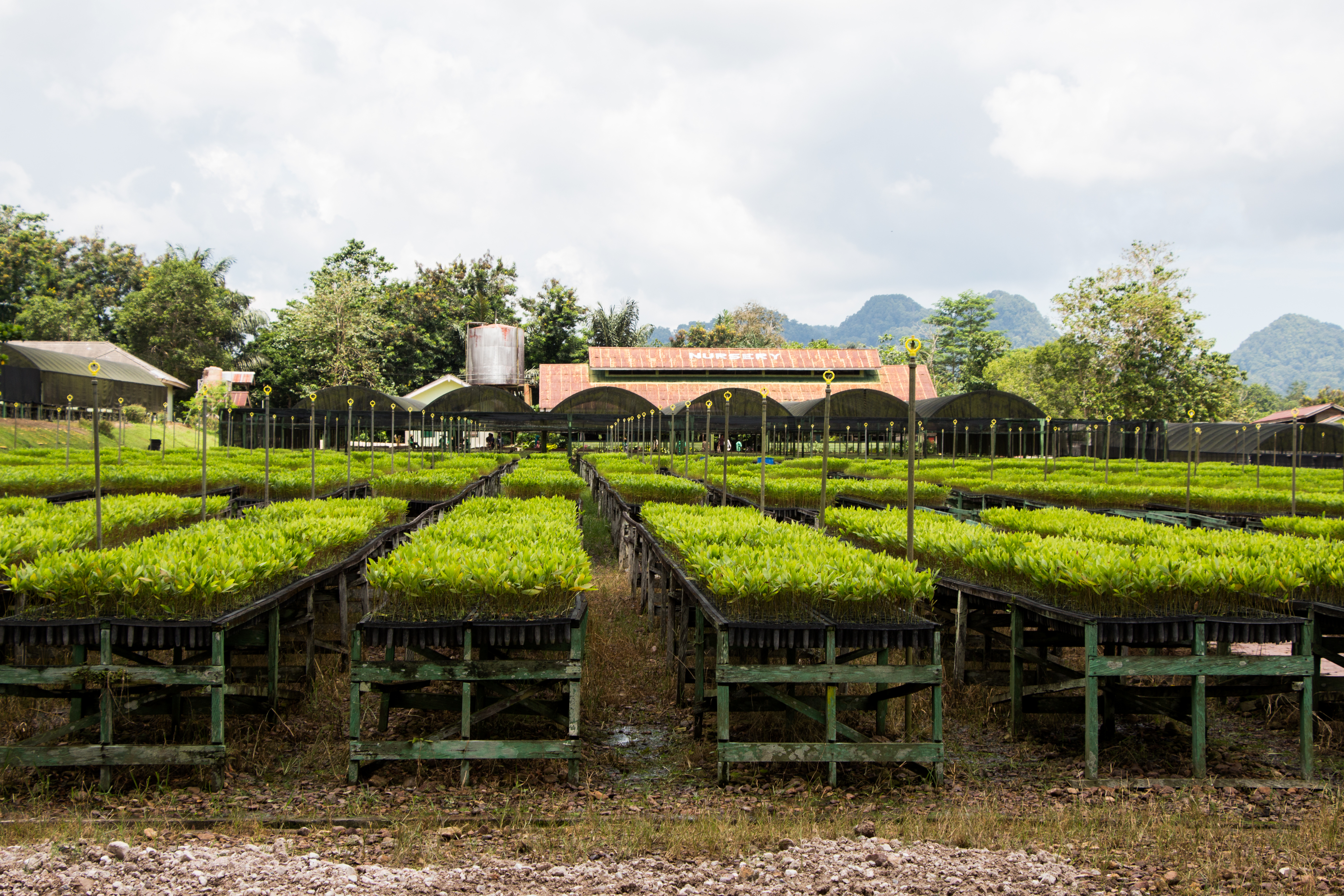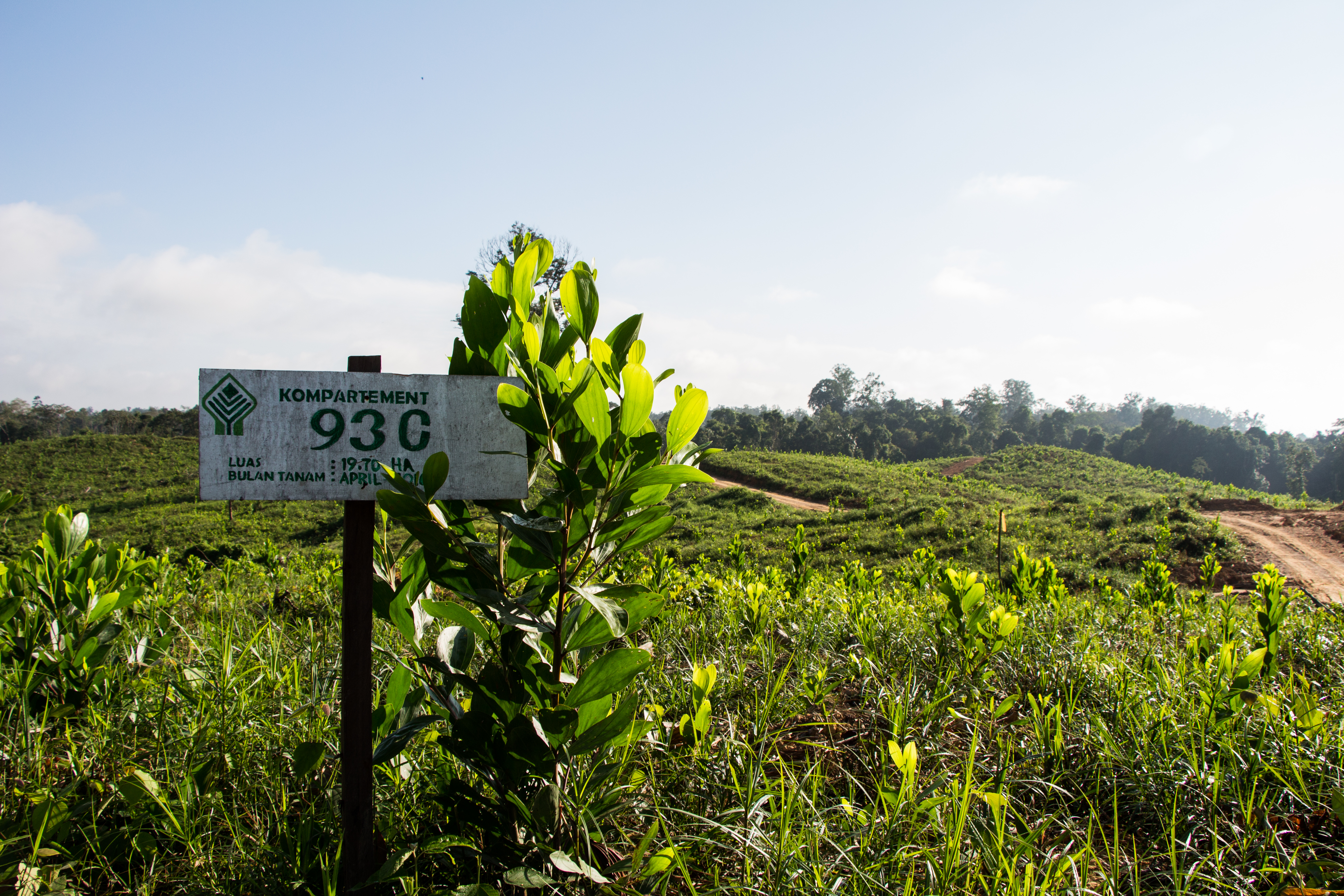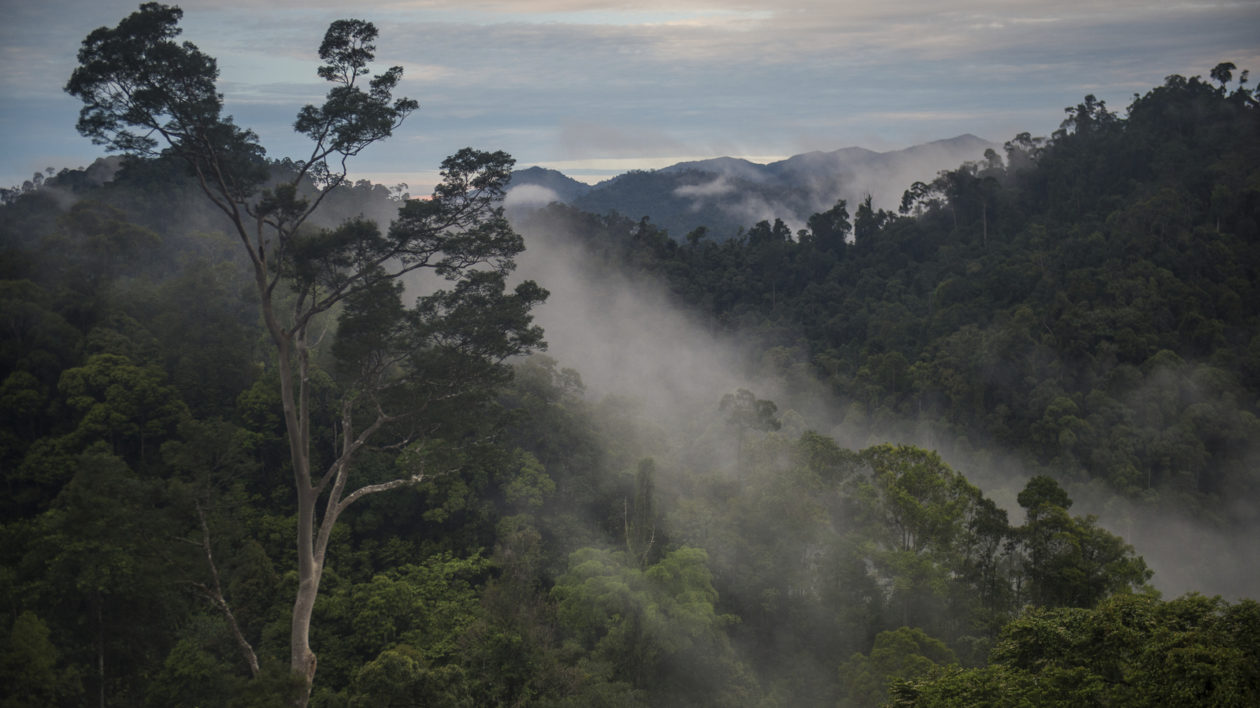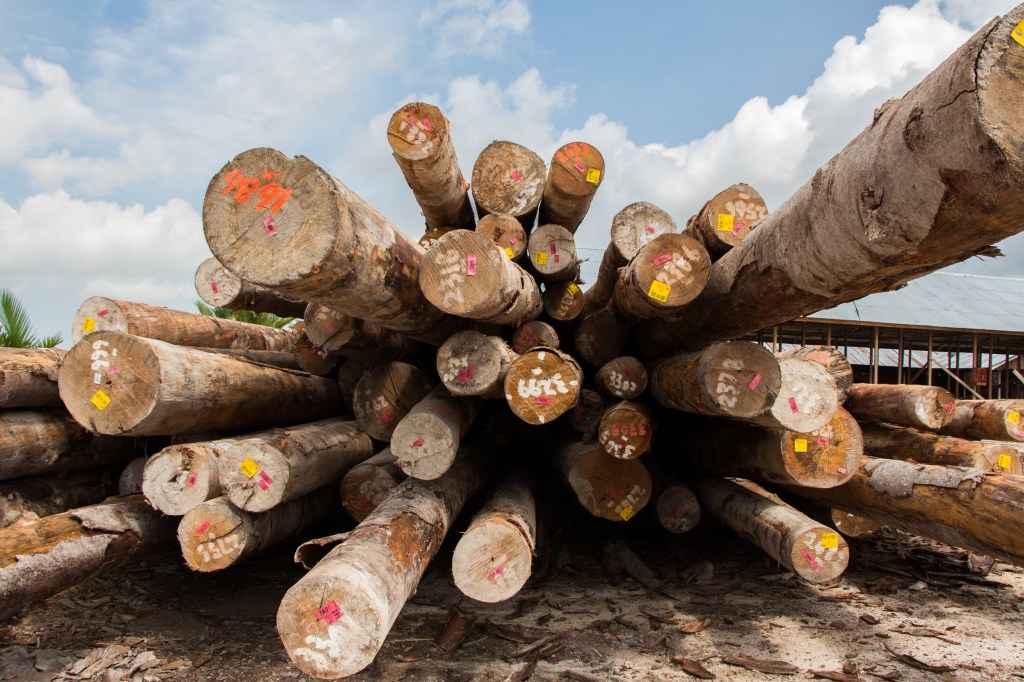I’m perched on a wooden tower 150 feet above the ground, eye-level with a centuries-old dipterocarp tree. Ahead the Indonesian rainforest ripples outward, high clouds casting shadows against the luminous green vegetation and red clay roads. Behind me, a mob of slender-billed crows chatters and shuffles in the canopy.
This may be my first time in Borneo, but this forest is anything but new to me. These same tropical hardwood trees — processed into plywood — form the walls of countless apartments, homes, offices, and stores back in the United States. The rolling plantations of oil palm and acacia are familiar, too, in the form of peanut-butter packets, soap, and notepaper tucked away in my backpack.
This landscape produces valuable timber, pulp for paper, and palm oil, all to the benefit of the Indonesian economy and people. But it’s also a global biodiversity hotspot, home to clouded leopards, gibbons, and orangutans. Without thoughtful management, species will be lost and the land exhausted.
A new analysis from the Science for Nature & People Partnership will determine which combination of land use — sharing or land sparing — in Indonesia’s Berau district is best for maintaining timber yields, while still protecting forest biodiversity, ecosystem services, and human well-being.
The Future of the Forest
Dipterocarps dominate Indonesia’s rainforests. Arrow-straight, smooth trunks rise skyward for dozens of meters before yawning into a stately crown, branches perfect for lounging orangutans and gleaning hornbills. About 260 of Borneo’s 4,000 tree species are dipterocarps, and they’re also the prime species targeted by the logging industry.
“Dipterocarp forests hold the most valuable tropical timber in the world,” says Bronson Griscom, director of forest carbon science at The Nature Conservancy. Once harvested, dipterocarp logs make their way downriver to a processing station, where they’re transformed into high-quality plywood and veneer bound for markets in Japan and South Korea.
An estimated 49 percent of land in Indonesia is still forested — 97 million hectares — and East Kalimantan is one of the most heavily forested provinces. In Berau, the section of East Kalimantan where The Nature Conservancy works, more than 90 percent of the district still has natural forest cover, making it one of the few places in Borneo that still has relatively undisturbed lowland dipterocarp forests.
Dipterocarp forests hold the most valuable tropical timber in the world.
Bronson Griscom
Yet even here, deforestation and forest degradation are serious threats. Indonesia recently led Brazil in having the highest rates of deforestation in the tropics — which already experience more deforestation than any other forest biome — although Brazil may take the lead again.
Between 2000 and 2010, Indonesia lost 840,000 hectares of forest per year, accounting for 56 percent of all forest cover loss in Southeast Asia. Complicating measurements of forest loss is differentiating deforestation — from mining, oil palm, and pulp paper plantations — and the forest degradation caused by selective logging. The largest forest loss on the island of Kalimantan occurred within oil palm plantations (22.8 percent) followed by mixed concessions and logging concessions (14.8 percent and 14.9 percent).
About 10 percent of Indonesia’s land is designated as protected areas, but legally defined protected areas are not the only option for conservation. Logging concessions themselves are an important piece of the conservation puzzle, especially in areas like Berau, where 60 percent of remaining forest is allocated to logging concessions.
Research shows that selectively logged tropical forests can retain up to 80 to 100 percent of native flora and fauna species, if managed very carefully and logged at a low intensity. If this rate holds true in Berau, then retaining land in logging concessions, instead of converting to oil palm or fiber plantations, could be a major player in conservation.



Aside from valuable timber and immense biodiversity, these forests also hold other values critical for human and economic well-being. Indonesia’s forests provide vital products for people living in them — like rattan, honey, resins, and medicinal plants. The dense mat of tree roots lock in soil and prevent erosion and flooding during Indonesia’s torrential rains. Preliminary research suggests that forests may play a role in keeping people living in them healthy, shielding them from warmer temperatures. And billions of trees throughout the tropics sequester nearly 3 billion of tons of carbon per year from the atmosphere, acting as the single greatest terrestrial carbon sink on earth.
At the same time, the Indonesian government has set targets for increasing economic growth and wood production. Maintaining wood production is key to halting climate change, because wood is one of the most sustainable building materials available: it’s biodegradable and it requires less energy to harvest and transport than other materials.
The Conservancy’s Indonesia program has worked with the government and logging concessions for more than 15 years. “We support the concessions in forest planning, helping them implement practices that produced low impacts on forests so that they can meet the standards required by the Government of Indonesia and to pursue voluntary Forest Stewardship Council certification,” says Herlina Hartanto, the Conservancy’s Indonesia terrestrial program. “We also engage surrounding communities in forest management.”
Protecting forest is critical, but it’s just one of many options for conservation. “People are part of the equation, and if we want to transform larger systems then we have to get into the messy world of commodity production systems and make them better,” says Griscom. “That brings us to a simple question: how do we achieve the greatest conservation and other human well-being outcomes while maintaining the fundamental commodity products from this landscape?”
The two possible solutions emerge, often called land sharing and land sparing. Sharing involves low-intensity use across most or all of the landscape, which in Berau means some form of selective logging. Land sparing involves converting a small patch of land to a more intensive use, like oil palm or acacia plantations, and setting the rest aside as protected forest.
“Our SNAPP group is trying to step beyond this dichotomy,” says Griscom. “It’s probably not just one or the other, but a mix of both depending on where you are in the landscape.”



Biodiversity, Watersheds, Human Well-being, & Carbon
The challenge with sharing vs sparing is that it all depends on priorities. A scenario that looks to maximize biodiversity conservation could look starkly different from one that prioritizes carbon sequestration. The SNAPP analysis will model what combinations of sharing & sparing are needed to maintain target wood production while also prioritizing four major forest services: biodiversity conservation, hydrological services, carbon sequestration, and human well-being.
As part of the biodiversity analysis, lead scientist for Asia Pacific Eddie Game, conservation geographer Tim Boucher, and tropical forest ecologist Zuzana Burivalova are training the Conservancy’s Indonesia program in gathering acoustic soundscapes from Berau’s forest. These landscape-scale data will enable them to better understand how different land uses impact biodiversity. They will compare species richness and species similarity in acacia and oil palm plantations, protected forests, and forests logged by both selective and conventional logging operations.
Indonesia’s forests are critical for watershed health; they help mitigate floods, control soil erosion, and safeguard drinking water quality. But those benefits are often poorly integrated or entirely missing from planning for forestry landscapes. Jessie Wells, at the University of Queensland, previously examined how local people perceive and value the watershed services provided by Borneo’s forests. Now, she will build on this analysis to run hydrological models to estimate erosion, sediment loads, and peak flows using LIDAR and stream-flow data. She will then compare these services under four different management scenarios: protected forest, conventional logging, reduced impact logging, and timber plantations.
“We’ll then expand to the scale of East Kalimantan,” says Wells, “mapping hydrological benefits across the landscape so that watershed services can be incorporated into spatial planning for forest sharing and sparing.”
Beyond watersheds, the SNAPP group will also consider other ecosystem services that directly impact human well-being. Daniela Miteva, an environmental economist at The Ohio State University, studies how FSC certification in Indonesia affects human well-being through metrics capturing poverty, education, health, and the availability of funding to meet village needs.
For SNAPP, she will model the relationship between forest management, forest loss, and various indicators of human welfare. “We want to understand the impact of different forest management practices and forest loss on both human health forest health, and ecosystem services,” says Miteva.
The final piece of the SNAPP analysis will focus on what combination of sharing and sparing maximizes carbon sequestration outcomes while still meeting target timber yields and profits. Preliminary results from Conservancy research indicate that tropical forest systems have the highest climate mitigation potential of any natural system on earth. Improved tropical forestry can play a big part of unlocking that opportunity, both by minimizing logging emissions and if loggers can help resist deforestation.
Griscom and his colleagues previously developed a methodology to measure carbon-emission reductions from the implementation of low-impact logging practices, called RIL-C. Now, the Conservancy’s Indonesia program in quantifying the potential emissions reductions from implementing those RIL-C practices across a 1,000-hectare test site. And research from Ruslandi, at the University of Florida, will quantify the relationships between carbon, timber yields, and profits for each of the five land types.
“Until now there has been no simple method to estimate the contribution of sustainable forest management to emissions,” says Delon Marthinus, a climate and forestry specialist in the Conservancy’s Indonesia program. An estimated 80 percent of Indonesia’s’ carbon emissions come from forestry and forest loss, so reducing logging emissions will be critical to the country’s ability to meet their requirements under the Paris Agreement.

All four of these research streams will feed into a larger spatial modeling analysis that will model various land-management scenarios, including a combined analysis that integrates all four priorities at both the concession and province scale.
“We will develop hypothetical spatial plans for forest sharing and sparing, one adhering to the existing land allocations, and an alternative scenario that allows for the re-allocation of existing management zones,” says Rebecca Runting, an environmental decision scientist at The University of Queensland and lead on the analysis. “Delivering multiple objectives may require a mix of strategies, as biodiversity and ecosystem services could have different responses to the intensification of forest management.”
Existing land allocations in Indonesia’s provincial-level land use plan could be tricky to change, but the SNAPP analysis has the potential to greatly influence how areas within pre-allocated land-use categories are developed. “For example, in the area allocated for plantation development, these results can inform which parts of the area should be converted into plantations and which areas should be best put aside or exempted from conversion due to high biodiversity,” says Hartanto.
Back in the field, a woody, spicy scent fills the air as we trek across the rolling clearing, woody remnants from last year’s harvest crunching underfoot. We’re in a different kind of forest today, recording acoustic data in an Acacia mangium plantation.
At the nursery, row upon row of elevated planters steam in the noon sun, filled with hundreds of waving, red-stemmed seedlings. Two women are hand planting a new bed beneath a shaded canopy, carefully selecting two or three seeds from a porcelain bowl and placing them into narrow, black plastic tubes.
Within a few years these seedlings will make the journey from nursery to field to papermill. And by the time they do, we’ll be one step closer to understanding how we can use strategic land-use planning to best use Berau’s land — for both people and nature.




Join the Discussion
1 comment